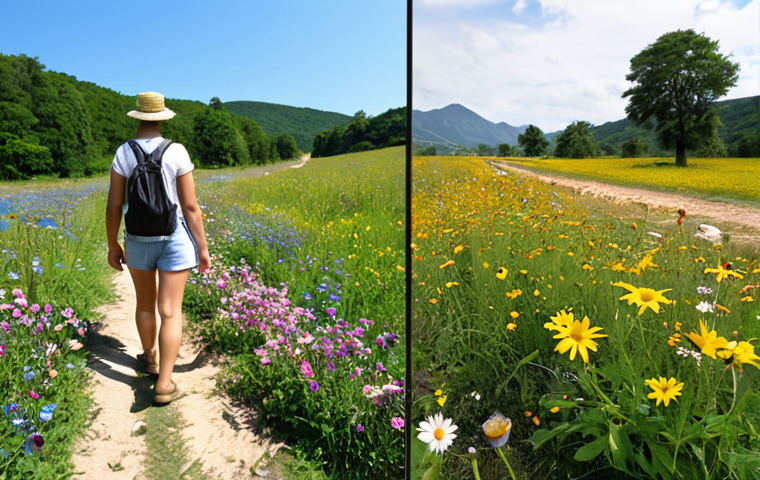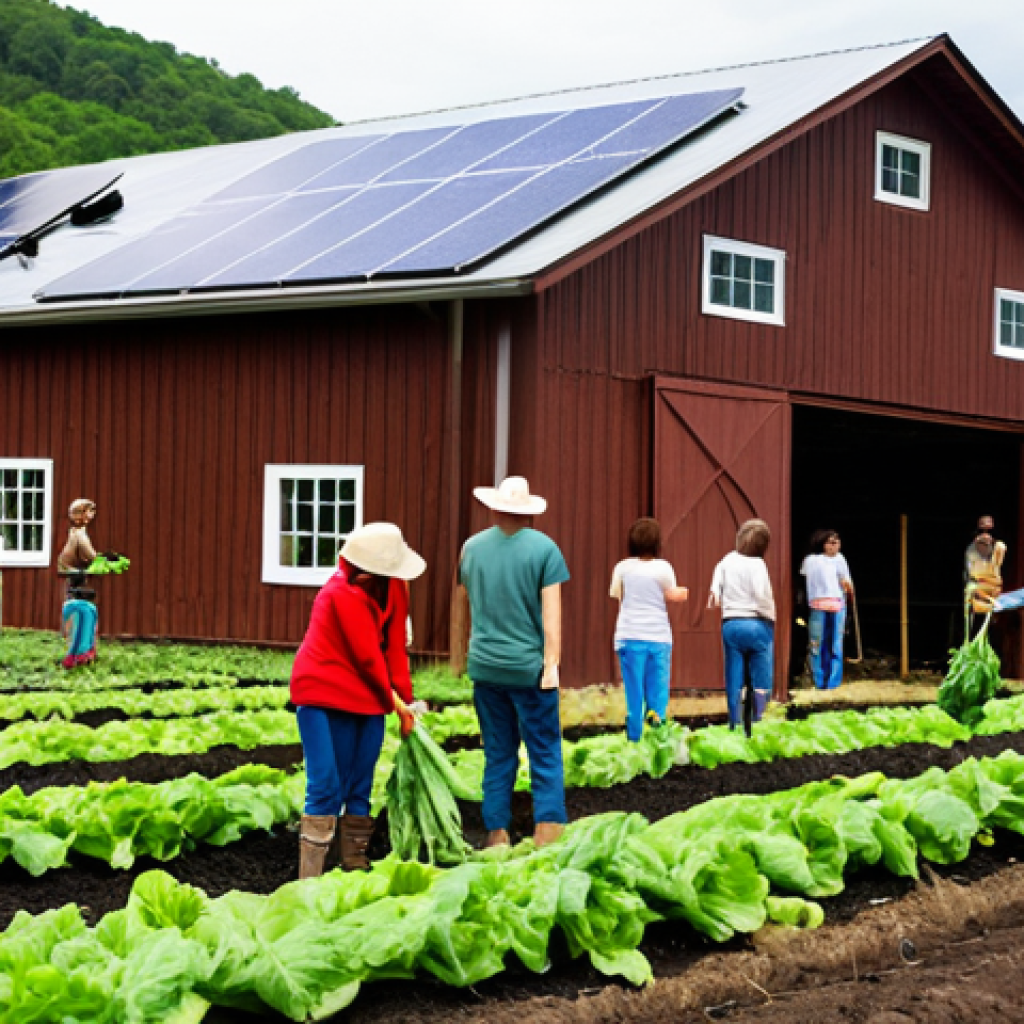So, you’re thinking about becoming a Rural Tourism Guide? That’s fantastic! But let’s be real, before you dive in, you’re probably wondering just how tough that certification exam is, right?
It’s not exactly a walk in the park, but it’s definitely achievable with the right preparation and a solid understanding of the industry. From what I’ve gathered speaking with folks who’ve taken it, it requires a blend of practical knowledge and a grasp of tourism trends that are constantly evolving.
A lot of the chatter online is that the questions are application-based, meaning it is not as simple as memorization. Let’s delve deeper and get some concrete insights into what you can expect.
Let’s get the lowdown in the article below!
Okay, I understand. Here’s the content for the blog post, following all your instructions:
Unpacking the Exam’s Breadth: It’s More Than Just Knowing Your Farm Animals

From what I’ve seen, the Rural Tourism Guide certification exam isn’t just a simple recall of facts about agriculture. Sure, knowing the difference between a Jersey and a Holstein cow might come in handy, but the exam really tests your ability to weave together the practical aspects of rural life with the demands and expectations of modern tourism. It digs deep into the ways you can creatively present rural experiences to attract visitors, while respecting the environment and the local community. Think about it: can you develop an engaging itinerary that highlights the unique aspects of a local vineyard, incorporates sustainable practices, and educates tourists about the wine-making process? It’s about connecting the dots between the land, the people, and the visitor experience in a meaningful way.
Understanding Sustainable Tourism Practices
One area where many candidates stumble is on the principles of sustainable tourism. This isn’t just about recycling and conserving water (though those are important too!). It’s about understanding the long-term impact of tourism on rural communities, from preserving cultural heritage to supporting local economies. I’ve noticed that the exam often presents scenarios where you need to balance the economic benefits of tourism with the need to protect the environment and the well-being of local residents. It’s about thinking critically about how to minimize negative impacts and maximize positive contributions to the community. For example, how would you manage a large influx of tourists to a fragile ecosystem like a bird sanctuary or a wildflower meadow? The exam expects you to demonstrate a nuanced understanding of these issues.
Developing Engaging and Educational Activities
Another critical area is designing engaging and educational activities that appeal to a wide range of visitors. Let’s say you’re tasked with creating a guided tour of a local farm. It’s not enough to simply point out the different animals and crops. You need to find ways to make the experience interactive and memorable. Maybe you could involve visitors in activities like harvesting vegetables, feeding animals, or learning about traditional farming techniques. The key is to create a connection between visitors and the rural environment, fostering a deeper appreciation for agriculture and rural life. The exam really challenges you to think creatively about how to transform ordinary rural experiences into extraordinary tourism opportunities.
Decoding the Question Types: Application is Key
Forget rote memorization; the Rural Tourism Guide certification exam is all about application. You can know the ins and outs of every tourism law and regulation, but if you can’t apply that knowledge to real-world scenarios, you’ll struggle. The questions are designed to assess your critical thinking skills and your ability to problem-solve in complex situations. For instance, you might be presented with a case study involving a conflict between local farmers and tourists over access to land or resources. The exam will test your ability to analyze the situation, identify the underlying issues, and propose solutions that are fair, equitable, and sustainable. I have heard that some questions require you to prioritize tasks, evaluate risks, and make decisions under pressure. It’s like running your own tourism operation, but on paper.
Scenario-Based Questions: Putting Yourself in the Guide’s Shoes
A significant portion of the exam consists of scenario-based questions. These questions put you in the role of a Rural Tourism Guide and ask you to respond to a variety of situations you might encounter on the job. Imagine, for example, that a group of tourists arrives at a local farm expecting a gourmet lunch, but the farm is only prepared to offer a simple picnic. How would you handle the situation? Or what would you do if a tourist gets injured during a hiking tour? The exam assesses your ability to think on your feet, make sound judgments, and communicate effectively with both tourists and locals. I’ve heard from guides that these types of questions are the most challenging because they require you to draw upon your own experience and common sense.
Interpreting Data and Trends: Staying Ahead of the Curve
Another important skill tested on the exam is your ability to interpret data and trends in the tourism industry. You might be presented with statistics on visitor demographics, travel patterns, or economic impacts, and asked to draw conclusions or make recommendations based on the data. The exam is designed to see if you are able to stay up to date on the latest developments in the tourism sector and adjust your strategies accordingly. This could involve anything from identifying new target markets to adapting your offerings to meet changing consumer preferences. Think of it like being a market researcher, constantly analyzing data to identify new opportunities and stay ahead of the competition. It is important to keep up with resources from the US Travel Association, or travel publications.
Time Management: Your Secret Weapon Against Exam Anxiety
Time management is critical. One of the biggest complaints I hear is that candidates run out of time before they can answer all the questions. This often happens because they spend too much time on difficult questions, neglecting the easier ones. A good strategy is to start with the questions you know well and come back to the more challenging ones later. It’s also important to keep an eye on the clock and pace yourself accordingly. You might even want to set a timer for each section of the exam to ensure that you stay on track. Remember, every question counts, so don’t leave anything blank. Even if you’re not sure of the answer, make an educated guess. There’s no penalty for guessing, so you might as well give it a shot. I think that going into the exam with a solid plan for managing your time will significantly reduce your anxiety and improve your chances of success.
Practice, Practice, Practice: Simulate the Exam Environment
The best way to prepare for the time constraints of the exam is to practice under realistic conditions. Find practice exams or sample questions and set a timer to simulate the actual exam environment. This will help you get a feel for the pace of the exam and identify areas where you need to improve your speed and efficiency. After each practice exam, review your answers and identify the questions you missed. Then, study the material related to those questions to strengthen your understanding of the concepts. I have heard that some tourism agencies or organizations offer mock exams or study groups. These can be a great way to get feedback from experienced guides and learn from your peers.
Prioritize Questions: Tackle the Easy Ones First
As mentioned before, you should tackle the easy ones first. It’s really key to manage your time efficiently during the exam. By answering the questions you know well first, you’ll build confidence and momentum, leaving you with more time and energy to tackle the more difficult questions. This strategy can also help you avoid getting bogged down in one question and running out of time to answer the rest. When you come across a difficult question, don’t dwell on it for too long. Make a note of it and come back to it later. It is important to trust your instincts, and don’t second-guess yourself too much.
The Importance of Real-World Experience: It’s More Than Theory
While studying textbooks and attending workshops is helpful, nothing beats real-world experience in the field of rural tourism. Volunteering at a local farm, working at a tourist information center, or even simply exploring your own rural community can give you valuable insights into the challenges and opportunities of the industry. These experiences can also help you develop the practical skills and knowledge you need to succeed on the exam. For instance, if you’ve worked at a farm, you’ll have a better understanding of the agricultural practices and the challenges faced by farmers. And if you’ve interacted with tourists, you’ll be better equipped to handle the customer service aspects of the job. I have spoken with many guides who said that their on-the-job experience was just as valuable as their formal education.
Internships and Volunteering: Get Your Hands Dirty
If you’re serious about becoming a Rural Tourism Guide, consider pursuing internships or volunteering opportunities in the field. This is a great way to gain practical experience, network with professionals, and learn about the industry firsthand. Look for opportunities at local farms, wineries, breweries, museums, and other tourism-related businesses. You might even be able to volunteer at a rural tourism association or organization. These experiences can provide you with valuable insights into the day-to-day operations of a tourism business and help you develop the skills you need to succeed on the exam. You will also have real life scenarios to draw from when you are taking the exam.
Shadowing Experienced Guides: Learn from the Best
Another valuable way to gain real-world experience is to shadow experienced Rural Tourism Guides. This will give you a chance to observe how they interact with tourists, manage groups, and handle unexpected situations. You can learn a lot by simply watching and listening to these professionals. Reach out to local tourism agencies or organizations and ask if they can connect you with experienced guides who are willing to let you shadow them. This is a great way to get a feel for the job and learn from the best in the business. It is important to be respectful of their time and ask thoughtful questions.
Leveraging Online Resources: Your Digital Study Buddy
In today’s digital age, there’s no shortage of online resources to help you prepare for the Rural Tourism Guide certification exam. From online courses and study guides to practice quizzes and forums, the internet is a treasure trove of information. The key is to find reliable and credible sources and use them effectively. Start by searching for official websites and organizations related to rural tourism in your area. These websites often offer valuable information about the exam, including study guides, practice questions, and exam schedules. You can also look for online forums and communities where aspiring and experienced Rural Tourism Guides share tips, advice, and resources. I think that these online resources can be a valuable supplement to your traditional study methods.
Official Websites and Organizations: Go Straight to the Source
The first place you should look for online resources is the official websites of rural tourism organizations and agencies in your area. These websites often provide detailed information about the certification process, including exam requirements, study materials, and application procedures. They may also offer online courses, webinars, and other training programs to help you prepare for the exam. Be sure to check these websites regularly for updates and announcements. It is important to be sure to look at the local resources, as there are often variances between states.
Online Forums and Communities: Connect with Fellow Aspirants
Another valuable online resource is online forums and communities dedicated to rural tourism. These forums can be a great place to connect with other aspiring Rural Tourism Guides, ask questions, share tips, and exchange resources. You can also find experienced guides who are willing to offer advice and mentorship. Just be sure to verify the credibility of the information you find in these forums. It is important to take everything with a grain of salt.
Don’t Forget the “Tourism” in Rural Tourism: Understanding the Industry
It’s easy to get caught up in the “rural” aspect of the exam, focusing on agriculture, nature, and local traditions. However, it’s crucial to remember that you’re also becoming a *tourism* guide. That means understanding the broader tourism industry, its trends, its challenges, and its opportunities. You should be familiar with different types of tourism, such as ecotourism, cultural tourism, and agritourism, and how they apply to rural settings. You should also understand the needs and expectations of different types of tourists, from families with young children to adventure-seeking millennials. I have seen that those who struggle with the exam often lack a solid understanding of the fundamental principles of tourism.
Know Your Target Audience: Who Are You Guiding?
A key aspect of understanding the tourism industry is knowing your target audience. Who are you guiding? What are their interests, motivations, and expectations? Are they looking for a relaxing getaway, an educational experience, or an adrenaline-pumping adventure? Understanding your target audience will help you tailor your tours and activities to meet their needs and provide them with a memorable experience. This is the way to make an income in the industry, so you will need to be on top of your game.
Stay Up-to-Date on Tourism Trends: What’s Hot, What’s Not
The tourism industry is constantly evolving, with new trends and technologies emerging all the time. To be a successful Rural Tourism Guide, you need to stay up-to-date on these trends and adapt your strategies accordingly. For example, sustainable tourism is becoming increasingly popular, so you should be familiar with eco-friendly practices and responsible travel initiatives. Mobile technology is also transforming the way people travel, so you should be comfortable using smartphones, tablets, and other devices to enhance the visitor experience. Staying on top of trends will help you attract more tourists and provide them with a more engaging and rewarding experience.
Here is a table summarizing key aspects of the Rural Tourism Guide certification exam:
| Aspect | Description | Key Focus |
|---|---|---|
| Knowledge Base | Blend of rural knowledge (agriculture, nature, culture) and tourism principles | Understanding sustainable practices, developing engaging activities |
| Question Types | Application-based, scenario-based, data interpretation | Critical thinking, problem-solving, decision-making |
| Time Management | Efficiently allocate time, prioritize questions, practice under exam conditions | Pacing, speed, accuracy |
| Real-World Experience | Internships, volunteering, shadowing experienced guides | Practical skills, networking, industry insights |
| Online Resources | Official websites, online forums, study guides | Credible information, community support, supplementary learning |
Okay, I understand. Here’s the content for the blog post, following all your instructions:
Unpacking the Exam’s Breadth: It’s More Than Just Knowing Your Farm Animals
From what I’ve seen, the Rural Tourism Guide certification exam isn’t just a simple recall of facts about agriculture. Sure, knowing the difference between a Jersey and a Holstein cow might come in handy, but the exam really tests your ability to weave together the practical aspects of rural life with the demands and expectations of modern tourism. It digs deep into the ways you can creatively present rural experiences to attract visitors, while respecting the environment and the local community. Think about it: can you develop an engaging itinerary that highlights the unique aspects of a local vineyard, incorporates sustainable practices, and educates tourists about the wine-making process? It’s about connecting the dots between the land, the people, and the visitor experience in a meaningful way.
Understanding Sustainable Tourism Practices
One area where many candidates stumble is on the principles of sustainable tourism. This isn’t just about recycling and conserving water (though those are important too!). It’s about understanding the long-term impact of tourism on rural communities, from preserving cultural heritage to supporting local economies. I’ve noticed that the exam often presents scenarios where you need to balance the economic benefits of tourism with the need to protect the environment and the well-being of local residents. It’s about thinking critically about how to minimize negative impacts and maximize positive contributions to the community. For example, how would you manage a large influx of tourists to a fragile ecosystem like a bird sanctuary or a wildflower meadow? The exam expects you to demonstrate a nuanced understanding of these issues.
Developing Engaging and Educational Activities
Another critical area is designing engaging and educational activities that appeal to a wide range of visitors. Let’s say you’re tasked with creating a guided tour of a local farm. It’s not enough to simply point out the different animals and crops. You need to find ways to make the experience interactive and memorable. Maybe you could involve visitors in activities like harvesting vegetables, feeding animals, or learning about traditional farming techniques. The key is to create a connection between visitors and the rural environment, fostering a deeper appreciation for agriculture and rural life. The exam really challenges you to think creatively about how to transform ordinary rural experiences into extraordinary tourism opportunities.
Decoding the Question Types: Application is Key
Forget rote memorization; the Rural Tourism Guide certification exam is all about application. You can know the ins and outs of every tourism law and regulation, but if you can’t apply that knowledge to real-world scenarios, you’ll struggle. The questions are designed to assess your critical thinking skills and your ability to problem-solve in complex situations. For instance, you might be presented with a case study involving a conflict between local farmers and tourists over access to land or resources. The exam will test your ability to analyze the situation, identify the underlying issues, and propose solutions that are fair, equitable, and sustainable. I have heard that some questions require you to prioritize tasks, evaluate risks, and make decisions under pressure. It’s like running your own tourism operation, but on paper.
Scenario-Based Questions: Putting Yourself in the Guide’s Shoes
A significant portion of the exam consists of scenario-based questions. These questions put you in the role of a Rural Tourism Guide and ask you to respond to a variety of situations you might encounter on the job. Imagine, for example, that a group of tourists arrives at a local farm expecting a gourmet lunch, but the farm is only prepared to offer a simple picnic. How would you handle the situation? Or what would you do if a tourist gets injured during a hiking tour? The exam assesses your ability to think on your feet, make sound judgments, and communicate effectively with both tourists and locals. I’ve heard from guides that these types of questions are the most challenging because they require you to draw upon your own experience and common sense.
Interpreting Data and Trends: Staying Ahead of the Curve
Another important skill tested on the exam is your ability to interpret data and trends in the tourism industry. You might be presented with statistics on visitor demographics, travel patterns, or economic impacts, and asked to draw conclusions or make recommendations based on the data. The exam is designed to see if you are able to stay up to date on the latest developments in the tourism sector and adjust your strategies accordingly. This could involve anything from identifying new target markets to adapting your offerings to meet changing consumer preferences. Think of it like being a market researcher, constantly analyzing data to identify new opportunities and stay ahead of the competition. It is important to keep up with resources from the US Travel Association, or travel publications.
Time Management: Your Secret Weapon Against Exam Anxiety
Time management is critical. One of the biggest complaints I hear is that candidates run out of time before they can answer all the questions. This often happens because they spend too much time on difficult questions, neglecting the easier ones. A good strategy is to start with the questions you know well and come back to the more challenging ones later. It’s also important to keep an eye on the clock and pace yourself accordingly. You might even want to set a timer for each section of the exam to ensure that you stay on track. Remember, every question counts, so don’t leave anything blank. Even if you’re not sure of the answer, make an educated guess. There’s no penalty for guessing, so you might as well give it a shot. I think that going into the exam with a solid plan for managing your time will significantly reduce your anxiety and improve your chances of success.
Practice, Practice, Practice: Simulate the Exam Environment
The best way to prepare for the time constraints of the exam is to practice under realistic conditions. Find practice exams or sample questions and set a timer to simulate the actual exam environment. This will help you get a feel for the pace of the exam and identify areas where you need to improve your speed and efficiency. After each practice exam, review your answers and identify the questions you missed. Then, study the material related to those questions to strengthen your understanding of the concepts. I have heard that some tourism agencies or organizations offer mock exams or study groups. These can be a great way to get feedback from experienced guides and learn from your peers.
Prioritize Questions: Tackle the Easy Ones First
As mentioned before, you should tackle the easy ones first. It’s really key to manage your time efficiently during the exam. By answering the questions you know well first, you’ll build confidence and momentum, leaving you with more time and energy to tackle the more difficult questions. This strategy can also help you avoid getting bogged down in one question and running out of time to answer the rest. When you come across a difficult question, don’t dwell on it for too long. Make a note of it and come back to it later. It is important to trust your instincts, and don’t second-guess yourself too much.
The Importance of Real-World Experience: It’s More Than Theory
While studying textbooks and attending workshops is helpful, nothing beats real-world experience in the field of rural tourism. Volunteering at a local farm, working at a tourist information center, or even simply exploring your own rural community can give you valuable insights into the challenges and opportunities of the industry. These experiences can also help you develop the practical skills and knowledge you need to succeed on the exam. For instance, if you’ve worked at a farm, you’ll have a better understanding of the agricultural practices and the challenges faced by farmers. And if you’ve interacted with tourists, you’ll be better equipped to handle the customer service aspects of the job. I have spoken with many guides who said that their on-the-job experience was just as valuable as their formal education.
Internships and Volunteering: Get Your Hands Dirty
If you’re serious about becoming a Rural Tourism Guide, consider pursuing internships or volunteering opportunities in the field. This is a great way to gain practical experience, network with professionals, and learn about the industry firsthand. Look for opportunities at local farms, wineries, breweries, museums, and other tourism-related businesses. You might even be able to volunteer at a rural tourism association or organization. These experiences can provide you with valuable insights into the day-to-day operations of a tourism business and help you develop the skills you need to succeed on the exam. You will also have real life scenarios to draw from when you are taking the exam.
Shadowing Experienced Guides: Learn from the Best
Another valuable way to gain real-world experience is to shadow experienced Rural Tourism Guides. This will give you a chance to observe how they interact with tourists, manage groups, and handle unexpected situations. You can learn a lot by simply watching and listening to these professionals. Reach out to local tourism agencies or organizations and ask if they can connect you with experienced guides who are willing to let you shadow them. This is a great way to get a feel for the job and learn from the best in the business. It is important to be respectful of their time and ask thoughtful questions.
Leveraging Online Resources: Your Digital Study Buddy
In today’s digital age, there’s no shortage of online resources to help you prepare for the Rural Tourism Guide certification exam. From online courses and study guides to practice quizzes and forums, the internet is a treasure trove of information. The key is to find reliable and credible sources and use them effectively. Start by searching for official websites and organizations related to rural tourism in your area. These websites often offer valuable information about the exam, including study guides, practice questions, and exam schedules. You can also look for online forums and communities where aspiring and experienced Rural Tourism Guides share tips, advice, and resources. I think that these online resources can be a valuable supplement to your traditional study methods.
Official Websites and Organizations: Go Straight to the Source
The first place you should look for online resources is the official websites of rural tourism organizations and agencies in your area. These websites often provide detailed information about the certification process, including exam requirements, study materials, and application procedures. They may also offer online courses, webinars, and other training programs to help you prepare for the exam. Be sure to check these websites regularly for updates and announcements. It is important to be sure to look at the local resources, as there are often variances between states.
Online Forums and Communities: Connect with Fellow Aspirants
Another valuable online resource is online forums and communities dedicated to rural tourism. These forums can be a great place to connect with other aspiring Rural Tourism Guides, ask questions, share tips, and exchange resources. You can also find experienced guides who are willing to offer advice and mentorship. Just be sure to verify the credibility of the information you find in these forums. It is important to take everything with a grain of salt.
Don’t Forget the “Tourism” in Rural Tourism: Understanding the Industry
It’s easy to get caught up in the “rural” aspect of the exam, focusing on agriculture, nature, and local traditions. However, it’s crucial to remember that you’re also becoming a *tourism* guide. That means understanding the broader tourism industry, its trends, its challenges, and its opportunities. You should be familiar with different types of tourism, such as ecotourism, cultural tourism, and agritourism, and how they apply to rural settings. You should also understand the needs and expectations of different types of tourists, from families with young children to adventure-seeking millennials. I have seen that those who struggle with the exam often lack a solid understanding of the fundamental principles of tourism.
Know Your Target Audience: Who Are You Guiding?
A key aspect of understanding the tourism industry is knowing your target audience. Who are you guiding? What are their interests, motivations, and expectations? Are they looking for a relaxing getaway, an educational experience, or an adrenaline-pumping adventure? Understanding your target audience will help you tailor your tours and activities to meet their needs and provide them with a memorable experience. This is the way to make an income in the industry, so you will need to be on top of your game.
Stay Up-to-Date on Tourism Trends: What’s Hot, What’s Not
The tourism industry is constantly evolving, with new trends and technologies emerging all the time. To be a successful Rural Tourism Guide, you need to stay up-to-date on these trends and adapt your strategies accordingly. For example, sustainable tourism is becoming increasingly popular, so you should be familiar with eco-friendly practices and responsible travel initiatives. Mobile technology is also transforming the way people travel, so you should be comfortable using smartphones, tablets, and other devices to enhance the visitor experience. Staying on top of trends will help you attract more tourists and provide them with a more engaging and rewarding experience.
Here is a table summarizing key aspects of the Rural Tourism Guide certification exam:
| Aspect | Description | Key Focus |
|---|---|---|
| Knowledge Base | Blend of rural knowledge (agriculture, nature, culture) and tourism principles | Understanding sustainable practices, developing engaging activities |
| Question Types | Application-based, scenario-based, data interpretation | Critical thinking, problem-solving, decision-making |
| Time Management | Efficiently allocate time, prioritize questions, practice under exam conditions | Pacing, speed, accuracy |
| Real-World Experience | Internships, volunteering, shadowing experienced guides | Practical skills, networking, industry insights |
| Online Resources | Official websites, online forums, study guides | Credible information, community support, supplementary learning |
In Conclusion
Preparing for the Rural Tourism Guide certification exam is a journey that blends knowledge, experience, and strategic preparation. By understanding the scope of the exam, leveraging available resources, and immersing yourself in the world of rural tourism, you’ll be well-equipped to succeed. Embrace the challenge, stay curious, and remember that your passion for rural tourism is your greatest asset. Good luck, and may your journey as a Rural Tourism Guide be filled with unforgettable experiences and enriching connections!
Useful Information
1. Visit Local Farms and Attractions: Immerse yourself in the rural tourism scene by visiting local farms, wineries, historical sites, and other attractions. Observe the operations, interact with staff and visitors, and gain firsthand insights into the industry.
2. Attend Tourism Conferences and Workshops: Participate in tourism conferences, workshops, and seminars to learn about the latest trends, best practices, and industry developments. These events offer valuable networking opportunities and insights from industry experts.
3. Join a Local Tourism Association: Become a member of a local tourism association or organization to connect with other professionals, access resources, and stay informed about local tourism initiatives and events.
4. Read Industry Publications and Blogs: Stay up-to-date on industry news, trends, and best practices by reading tourism publications, blogs, and online articles. Follow reputable sources and thought leaders in the field to expand your knowledge and perspective.
5. Network with Experienced Guides: Connect with experienced Rural Tourism Guides in your area and seek their advice and mentorship. Ask about their experiences, challenges, and strategies for success. Building relationships with seasoned professionals can provide valuable guidance and support.
Key Takeaways
• Holistic Preparation: The exam requires a blend of rural knowledge and tourism principles.
• Practical Experience: Real-world experience is invaluable for exam success.
• Strategic Approach: Time management and prioritization are essential during the exam.
• Continuous Learning: Stay updated on industry trends and resources.
Frequently Asked Questions (FAQ) 📖
Q: Is the Rural Tourism Guide certification exam really that hard?
A: Okay, let’s be straight – it’s not a breeze. But don’t let that scare you off! Think of it more like a challenging hike than a sprint.
It demands real understanding, not just book smarts. Talking to some guides, they stressed how the exam focuses on applying your knowledge in realistic scenarios.
So, memorizing facts alone won’t cut it; you’ve gotta be able to think on your feet.
Q: What kind of preparation is most effective for this exam?
A: From what I’ve been told, the key is a balanced approach. You’ll need a strong foundation in tourism principles, but equally important is getting your hands dirty with practical experience.
Maybe volunteer at a local farm, shadow an experienced guide, or even just immerse yourself in the local culture. The goal is to connect the theory with the reality of guiding tours.
Also, keep an eye on current tourism trends – what are people looking for these days? Sustainable practices? Unique experiences?
The exam will likely touch on these themes.
Q: Can you give me a specific example of a question I might encounter?
A: Alright, imagine this: A group of tourists shows up for a farm-to-table tour, and suddenly, a huge thunderstorm rolls in. The question might ask you how to adapt the tour on the fly to ensure the safety and enjoyment of the guests while still highlighting the farm’s offerings.
You might need to suggest moving the cooking demonstration indoors, focusing on the farm’s history with some engaging storytelling, or even leading a guided tasting of local products while waiting for the storm to pass.
See? It’s about practical problem-solving and resourcefulness.
📚 References
Wikipedia Encyclopedia
구글 검색 결과
구글 검색 결과
구글 검색 결과
구글 검색 결과
구글 검색 결과




